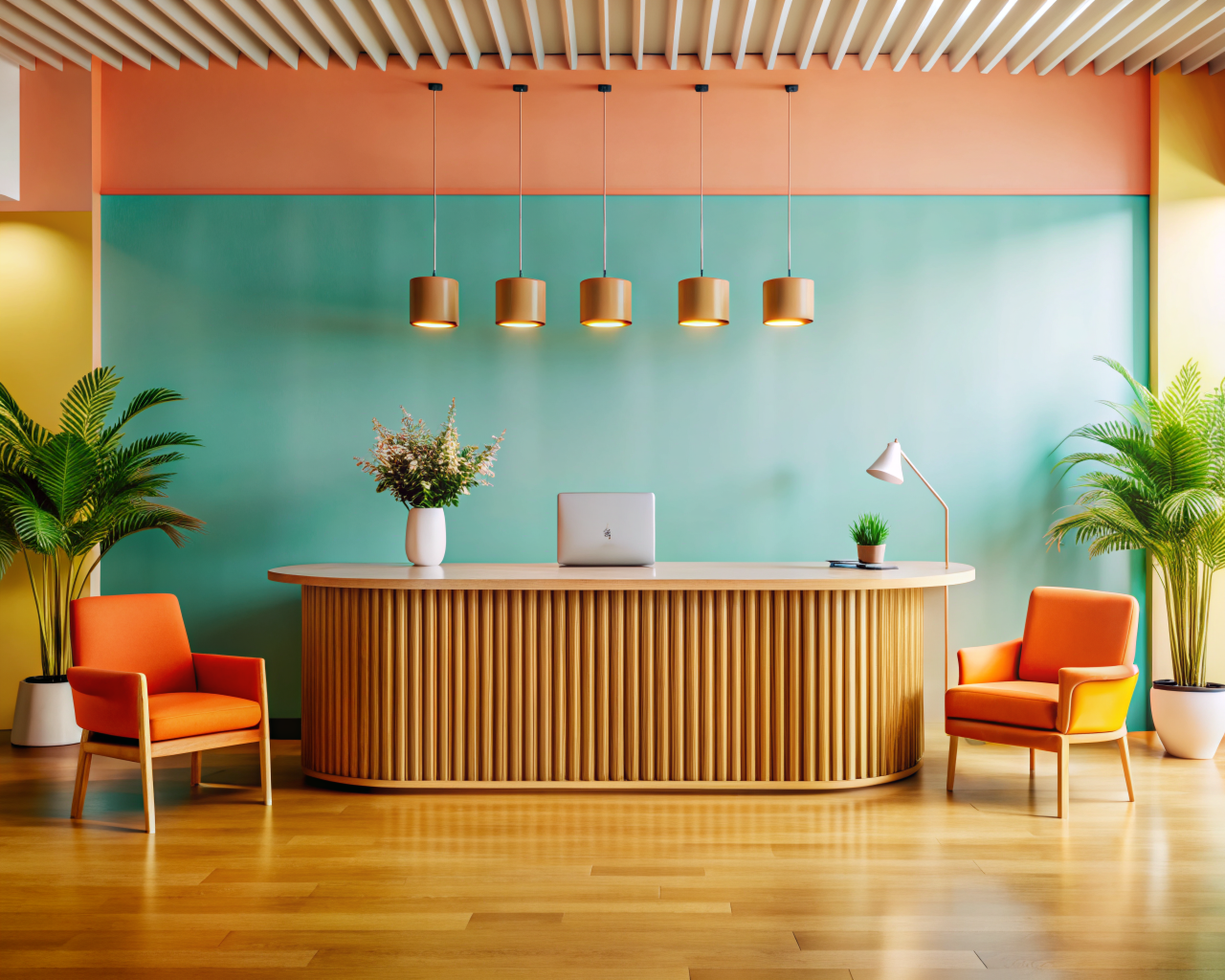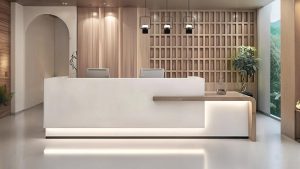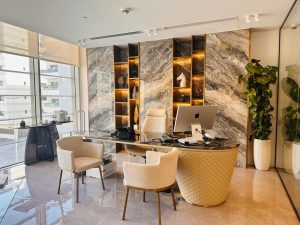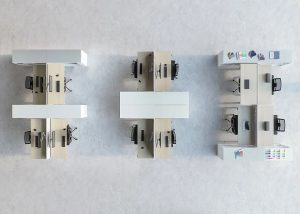Colors impact our emotions and behaviors significantly, making color psychology crucial in office furniture design. Companies aiming to enhance productivity, creativity, and well-being should consider the colors in their office furniture. This guide explores how different colors influence mood and performance in the workplace and offers insights into creating an office space aligned with your goals.
The Science Behind Color Psychology
Color psychology studies how colors affect human behavior and emotions. It shows that colors evoke specific psychological responses. This is used in marketing, branding, and interior design to create environments that elicit desired reactions. In office furniture, the right color choices can boost morale, improve focus, and enhance overall satisfaction.
Understanding Color Meanings
1. Blue: The Color of Calm and Focus
Blue is associated with calmness, stability, and reliability. It lowers stress levels and creates tranquility. In an office, blue furniture helps create a serene environment conducive to concentration and productivity. It is effective in high-stress industries where focus and composure are essential.
Furniture Ideas:
- Blue ergonomic chairs for comfort and stability.
- Blue desks or workstations for a calming atmosphere.
- Blue accent walls or partitions to incorporate the color subtly.
2. Green: The Color of Balance and Harmony
Green symbolizes nature, balance, and harmony. It reduces eye strain and creates a sense of equilibrium. Green is ideal for offices where employees spend long hours in front of screens, as it reduces fatigue and maintains a relaxed ambiance.
Furniture Ideas:
- Green desk accessories like organizers and pen holders.
- Green plants and living walls to bring nature indoors.
- Green upholstered chairs and lounge furniture for breakout areas.
3. Yellow: The Color of Energy and Optimism
Yellow is associated with energy, optimism, and creativity. It inspires innovation and boosts morale. However, use yellow sparingly, as too much can be overwhelming and cause anxiety.
Furniture Ideas:
- Yellow accent chairs or cushions for a pop of color.
- Yellow desk lamps to brighten up workspaces.
- Yellow wall art or decor to infuse energy without overpowering.
4. Red: The Color of Passion and Excitement
Red is powerful, associated with passion, excitement, and urgency. It stimulates energy and increases heart rates, ideal for areas where lively discussions and brainstorming take place. Use it with caution, as it can also evoke aggression and stress if overused.
Furniture Ideas:
- Red meeting room chairs to energize discussions.
- Red breakout area furniture for a dynamic space.
- Red desk accessories for a bold touch at workstations.
5. Orange: The Color of Enthusiasm and Creativity
Orange symbolizes enthusiasm, creativity, and warmth. It is a welcoming color that boosts social interaction and collaboration. Orange is perfect for creative industries and collaborative workspaces.
Furniture Ideas:
- Orange lounge chairs and sofas for communal areas.
- Orange task chairs for a vibrant touch.
- Orange wall accents or partitions for a dynamic atmosphere.
6. Purple: The Color of Luxury and Imagination
Purple is associated with luxury, imagination, and wisdom. It inspires creativity and innovation while providing calm and introspection. Purple is great for offices encouraging creativity and forward-thinking.
Furniture Ideas:
- Purple upholstered chairs for elegance.
- Purple area rugs or curtains for sophistication.
- Purple desk accessories to inspire creativity.
7. Neutral Colors: The Colors of Simplicity and Professionalism
Neutral colors like white, gray, and beige symbolize simplicity, professionalism, and cleanliness. These colors provide a versatile backdrop easily complemented by other colors. They are ideal for a clean and uncluttered look, improving focus and productivity.
Furniture Ideas:
- White desks and storage units for a modern look.
- Gray office chairs and partitions for a sleek appearance.
- Beige lounge furniture for a warm and inviting atmosphere.
Combining Colors for Maximum Impact
Combining colors strategically enhances their impact and creates a balanced and dynamic office environment. Here are tips for combining colors in office furniture:
1. Create Color Zones
Designate specific areas with different colors to define their purpose and influence behavior. Use blue in focus areas, green in relaxation zones, and red in collaborative spaces.
2. Use Accent Colors
Incorporate accent colors through furniture and decor for visual interest. Accent colors highlight key areas and create focal points without overwhelming the space.
3. Balance Bold and Neutral Colors
Mix bold colors with neutral tones for a balanced look. Bold colors add energy and personality, while neutral colors provide a calming backdrop.
4. Consider Lighting
Lighting affects how colors are perceived. Ensure adequate lighting to complement the color scheme. Natural light enhances colors, making the space feel vibrant and inviting.
Practical Applications in Office Design
To leverage color psychology effectively, consider these practical applications:
1. Open Plan Offices
Use color to define zones and create organization in open plan offices. Use green furniture in relaxation areas, blue in quiet zones, and orange in collaborative spaces.
2. Private Offices
Choose colors reflecting the individual’s role and personality for private offices. Blue promotes focus for analytical roles, while purple inspires creativity for design roles.
3. Meeting Rooms
Use colors stimulating discussion and creativity in meeting rooms. Red and orange energize the space, while blue creates a calm environment for focused meetings.
4. Breakout Areas
Use vibrant and warm colors in breakout areas for a welcoming atmosphere. Yellow and orange boost energy and encourage social interaction.
Case Studies: Successful Use of Color in Office Furniture
1. Google
Google’s innovative office designs incorporate bold and vibrant colors. They use a mix of red, blue, yellow, and green to create a dynamic and stimulating environment, encouraging creativity.
2. Microsoft
Microsoft’s offices feature a subdued color palette with shades of blue and green, creating a calming and focused environment aligning with their corporate identity and promoting productivity.
3. WeWork
WeWork’s co-working spaces use a variety of colors to cater to different needs and preferences. Their color use creates versatile and appealing work environments, from vibrant communal areas to calming private offices.
Conclusion
Thoughtful use of color in office furniture significantly impacts well-being, productivity, and workplace satisfaction. Understanding the psychological effects of colors and incorporating them strategically into office design creates a space that supports organizational goals.
Whether designing a new office or updating your current space, consider the power of color psychology. With the right colors, you can create an environment that inspires, energizes, and promotes team success.





